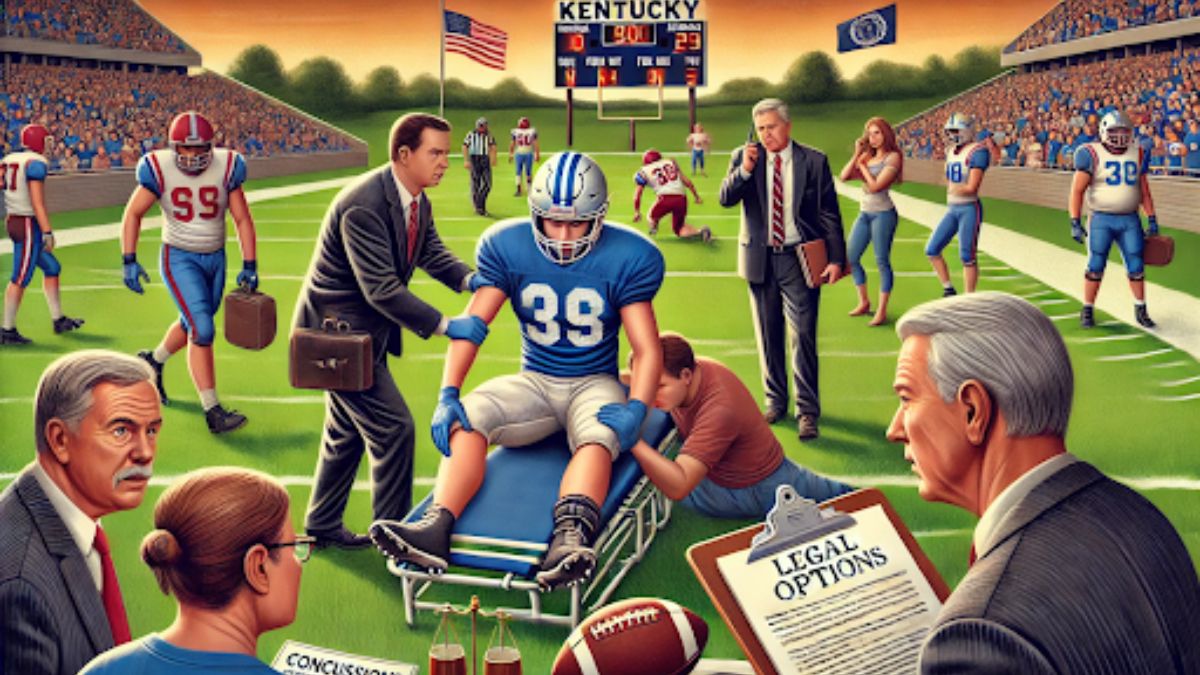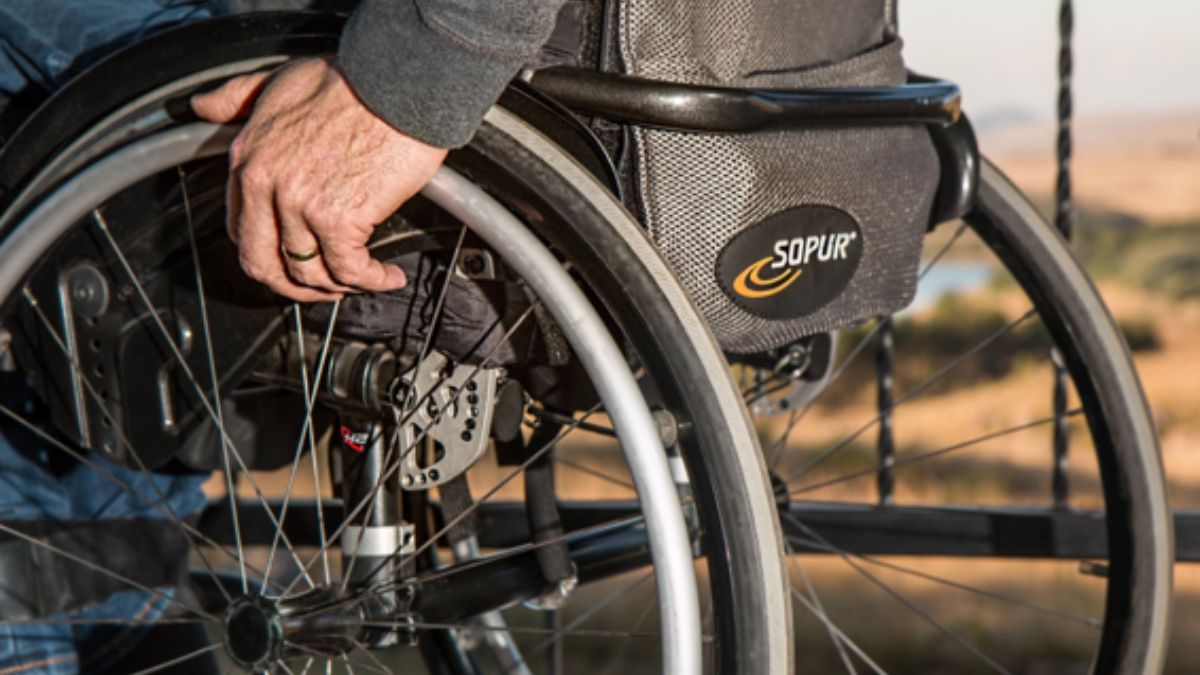LAW
Kentucky’s School Football: Concussions, Injuries, and Legal Options

Kentucky high school football players face significant risks of concussions and injuries, making it crucial for parents, coaches, and athletes to be well informed. Understanding the protocols and legal options available can ensure safer experiences and fair treatment. According to Kentucky High School Athletic Association guidelines, suspected concussions must be handled according to standardized procedures to minimize risks to student-athletes.
Football is one of the leading sports for concussion injuries in high schools, contributing to more than 40% of sport-related concussions. The ongoing study of these injuries emphasizes the need for rigorous safety measures to protect young athletes. If a school fails to follow appropriate protocols, affected families might need to seek legal assistance to address any negligence or worsened injuries.
Legal resources can be integral when injuries occur during school sports activities. Immediate medical attention is essential, but understanding your rights and the legal actions available can be equally important. Families may need to consult with personal injury lawyers to navigate the complexities of sports-related injuries and ensure that their children receive the best possible care and compensation.
Understanding Concussions in Kentucky High School Football
Concussions are a serious concern in Kentucky high school football, with numerous factors contributing to the occurrence and management of these injuries. The Kentucky High School Athletic Association (KHSAA) has implemented specific policies to address concussion risks and ensure the safety of student-athletes.
The Prevalence of Concussions in High School Athletes
High school football players in Kentucky experience concussions more frequently than athletes in other sports. Football players are 16 times more likely to suffer a concussion compared to their peers in baseball and four times more than male basketball players.
From 2013 to 2018, data shows a notable rise in concussion rates during high school football games, emphasizing the ongoing safety concerns. In Kentucky, aggressive play styles and physical contact inherent in football contribute significantly to injury rates.
Concussion Risks and Safety Measures
Concussions can have severe short-term and long-term effects on young athletes. Risk factors include the intensity and physicality of the sport, lack of proper technique, and insufficient protective equipment. Safety measures such as rule changes and improved training protocols have been introduced to mitigate these risks.
For instance, rule modifications like moving the kickoff line aim to reduce high-impact collisions. Coaches and sports trainers are also educated on recognizing concussion symptoms early, allowing for prompt medical intervention. The KHSAA mandates adherence to these guidelines to enhance player safety.
KHSAA Policies and Participation Bylaws
The KHSAA has established comprehensive guidelines to address concussion management. Their concussion protocol aligns with the Consensus Statement on Concussion in Sport, emphasizing the importance of treating suspected concussions with caution.
This protocol requires immediate removal from play for athletes suspected of having a concussion and mandates medical clearance before returning to the sport. Compliance with these bylaws ensures that coaches and administrators prioritize the health of student-athletes, reflecting a commitment to reducing concussive injuries in Kentucky high school football.
Legal Aspects and Player Safety Programs
Kentucky’s high school football programs prioritize athlete safety and offer legal pathways for concussion-related injuries. Guidelines from organizations like the NCAA and the Kentucky High School Athletic Association (KHSAA) play a crucial role.
High School Player Safety and NCAA Regulations
Player safety remains a top concern for high school football programs in Kentucky. The Kentucky High School Athletic Association enforces strict concussion protocols to minimize risks. These protocols are in line with the Consensus Statement on Concussion in Sport. The KHSAA’s Board of Control updates bylaws and guidelines annually, ensuring they adhere to current best practices.
The NCAA also issues guidance for concussion management. According to NCAA regulations, any athlete suspected of having a concussion must be immediately removed from play. This decision aligns with policies that prohibit same-day return to action. Kentucky’s 2023-24 guidelines document includes these approved protocols to enhance player safety effectively.
Legal Options for Concussion-Related Injuries
Athletes and their guardians have legal recourse if injuries result from inadequate safety measures. Law firms assist athletes whose injuries were mismanaged. Legal claims can address situations where proper care was neglected.
To pursue legal action, obtaining comprehensive medical documentation is critical. Claimants should demonstrate that appropriate concussion protocols were not followed. Such legal options drive better compliance with safety guidelines, holding organizations accountable. By pursuing these actions, they aim to ensure enhanced protection and well-being for all student-athletes.
In Conclusion
The issue of concussions in Kentucky’s high school football is a significant health concern. Preventative measures such as rule changes and updated protocols have shown positive impacts. For example, targeting rule implementation has decreased concussions by moving the kickoff line, which has increased touchbacks.
Additionally, statistics from 2012-2017 highlight the persistent challenges. High school football accounted for 6% of all injuries, with more concussions in games than in practices. This emphasizes the need for stricter safety measures during games.
Regulations alone are not enough. The broader context of regulating concussions in football shows the need for continuous dialogue and improvements. Historical data reflects a dire need for intervention, as seen in earlier high injury and fatality rates.
Parents, coaches, and school administrations play a crucial role. They must ensure compliance with protocols like those outlined in the Kentucky High School Athletic Association’s concussion protocol. This document provides essential guidelines for the treatment and management of suspected concussions.
Increased awareness and proactive measures are vital. Addressing these issues head-on can create a safer environment for student-athletes. Kentucky schools need to prioritize health alongside the sport’s competitive nature, ensuring the well-being of all participants. By doing so, they safeguard the future of high school football and protect the athletes who make it possible.
LAW
Steps to Take After an Accident: Legal and Practical Advice

Were you just in an accident and unsure of what to do next? It’s easy to feel scared or confused in that moment. Taking the right steps right away can protect your health and your rights.
Simple actions like calling for help, gathering info, and talking to a lawyer can make a big difference. You don’t have to face it all alone. Knowing what to do can save time, money, and stress.
Want to stay safe and protect yourself legally? Keep reading for clear steps to follow after an accident.
Ensure Safety
The first thing to do after an accident is to stay calm. Check yourself and others for injuries. If anyone is hurt, call emergency services right away. Move to a safe area if the location is dangerous.
Turn on your hazard lights to warn other drivers. Do not stand in traffic or near moving vehicles. If your car can be moved, pull it to the side of the road. Stay inside the car if it’s safer than being outside. Keeping yourself and others safe should be your top priority.
Call for Help
Right after an accident, call 911 as soon as you can. Even if the crash seems minor, it’s better to be safe. Emergency services can check for injuries and control the scene. The police will create an official report, which will help later. Stay calm and give clear details about the location.
Let them know if anyone is hurt or trapped. Do not leave the scene before help arrives. Follow any instructions given by the dispatcher. Getting help quickly can protect both your health and your legal rights.
Document the Scene
Take clear photos of the vehicles from different angles. Include any damage, license plates, and road conditions. Snap pictures of skid marks, debris, or traffic signs nearby. Write down the time and location of the accident. Get the names and contact info of any witnesses.
Ask for the other driver’s name, license number, and insurance details. Avoid arguments or admitting fault while gathering info. Note any weather or lighting conditions at the scene. The more details you collect, the stronger your case will be later.
Contact Insurance
After an accident, call your insurance company as soon as possible. Share basic details about what happened. Give them the date, time, and location of the crash. Tell them if there were any injuries or damage. Be honest, but avoid guessing or blaming anyone.
Send them photos and any documents you have. Ask what steps you need to follow next. Keep a record of who you speak with and what they say. Reporting the accident quickly helps protect your claim and speeds up the process.
Get Legal Advice
Talking to a lawyer after an accident can protect your rights. They can explain what to do and what to avoid. You might be owed money for injuries or damage. A lawyer can help you deal with insurance companies. They know how to handle tough questions and paperwork.
Look for trusted personal injury attorneys with good reviews. Many offer free consultations, so you can ask questions first. Don’t wait too long, as there are deadlines for filing claims. Getting legal help early can make the process less stressful.
Learn the Steps to Take After an Accident
After an accident, stay calm and think clearly. Your safety and health should come first. Gather important information while at the scene.
Report the accident and talk to trusted personal injury attorneys. Taking the right steps early can protect your rights and help you recover.
Visit our blog for more!
LAW
Understanding Liability in Theme Park Accidents

Theme parks offer fun rides, food, and exciting adventures. But accidents can happen, even during the best trips. Who is responsible when someone gets hurt?
Knowing who is liable helps victims take action. Injuries can come from faulty rides, slippery walkways, or poor safety. Rules protect visitors, but not all parks follow them.
Some ignore warnings or forget basic safety checks. What steps should you take after an accident?
This blog explains the basics of theme park liability. Keep reading to learn your rights and how to protect them.
What Liability Means in Theme Park Injury Cases
Liability means who is at fault for an injury. Theme parks must keep guests safe. If they don’t, they may be held responsible.
Slippery floors or broken rides can cause accidents. These are examples of negligence. Proving this fault is key in a legal case. Courts need evidence that safety rules were ignored.
Understanding this helps victims know what to expect. It also guides the steps to take after an injury.
Common Causes of Theme Park Accidents
Accidents happen in many ways. Wet floors can lead to slips. Ride malfunctions may throw passengers off balance.
Poor lighting makes walkways hard to see. Staff errors can create unsafe conditions. Improper ride maintenance is another danger.
Broken safety rails also cause harm. These issues point to the park’s responsibility. Victims must show how the park failed.
Knowing the common causes helps build a strong case. It also shows how injuries could have been avoided.
Proving Negligence After an Accident
To win a case, victims must prove negligence. This means the park failed to act with care. Evidence can include photos, videos, and witness statements.
Medical records also help show the damage done. Proving this fault is not always easy. Lawyers help gather and present the needed proof.
Timely action makes collecting evidence easier. Without proof, cases are harder to win. It is important to start quickly after the accident happens.
How a Lawyer Helps After a Theme Park Injury
Lawyers understand the rules that theme parks must follow. They know how to build strong legal cases. A theme park slip and fall attorney in Miami can help local victims.
They collect evidence, talk to witnesses, and file claims. Lawyers also deal with insurance companies. Their support gives victims a better chance to win.
They explain your rights and options clearly. Having legal help reduces stress during recovery.
Steps to Take Right After an Accident
Acting fast can protect your rights. First, report the injury to park staff. Then, take photos of the area and your injuries. Gather names of any witnesses nearby.
Get medical help, even for small injuries. Save all receipts and medical records. Don’t sign anything without legal advice.
These steps help if you file a claim later. The more proof you have, the stronger your case. Quick action can make a big difference in the outcome.
Know Your Rights After a Theme Park Accident
Theme park accidents are serious and can change lives. Victims need to know their rights and how to protect them. Liability depends on showing how the park was careless.
Acting quickly and getting legal help are both important. A skilled attorney can guide victims every step of the way. If you or someone you know was hurt, don’t wait.
Protect your future by learning what to do after a theme park accident. Knowing the law can lead to better outcomes.
Did you find this article helpful? If so, check out the rest of our site for more informative content.
LAW
Understanding Your Rights After a Personal Injury

Accidents can happen at any time. Whether it’s a car crash, a slip and fall, or something at work, the effects can be serious. Injuries can lead to medical bills, time away from work, and emotional stress. Many people don’t know what their rights are after an injury. Some wait too long to take action. Others don’t get the support they need. Understanding your rights after a personal injury is the first step toward getting fair treatment. Keep reading to learn more about your legal options and what steps you should take.
Know What Counts as a Personal Injury
A personal injury happens when someone gets hurt because of another person’s actions or negligence. This can include physical injuries, mental distress, or both.
Common examples include car accidents, dog bites, workplace accidents, and slips or falls. Not every accident qualifies, so it’s important to understand the legal standards.
Usually, you must prove the other party was careless. You also need to show how the injury affected your life. This can involve hospital records, police reports, or witness statements.
Knowing what qualifies can help you decide if you have a case. It also gives you a better idea of how to move forward.
Seek Medical Help Immediately
Always get medical attention after any injury, even if it seems minor. Some injuries don’t show symptoms right away. A full medical exam helps catch hidden problems. It also creates a record of your injuries.
This record is important if you decide to take legal action later. Waiting too long can hurt your case. Insurance companies might claim you weren’t really hurt. Timely care shows that you took your injury seriously. It also helps you recover faster and with fewer long-term issues.
Document Everything
Start gathering proof as soon as possible. Take photos of the scene and your injuries. Keep copies of medical records, bills, and prescriptions. Save any emails or messages related to the incident.
If there are witnesses, ask for their contact information. These details can help support your claim. The more proof you have, the stronger your case will be.
Staying organized will also make the legal process easier. Don’t throw anything away that might be useful later.
Understand Comparative Fault Rules
In some cases, both sides share blame for an accident. Laws about this vary by state. For example, if you were partly at fault, you might still get some compensation. This is called comparative fault.
The amount you receive could be reduced based on your share of responsibility. Knowing how this works is key to managing expectations. It also affects how much effort is needed to prove the other side’s fault.
A legal expert can explain how the rules apply in your area. You shouldn’t assume you’re not eligible without checking first. Sometimes, even a small percentage of fault doesn’t ruin your case.
Avoid Talking About the Case Online
Social media can hurt your case without you realizing it. Insurance companies check posts to find reasons to deny or lower payouts. Photos, check-ins, or comments can be used against you.
Even if your account is private, things can still leak. Don’t talk about the accident or your injuries online. Avoid posting pictures or updates until your case is resolved.
Ask friends and family not to tag you in related content. Keeping quiet protects your privacy and your claim. Focus on recovery and let your legal team do the talking.
Know the Time Limits to File
There are deadlines for filing personal injury claims. These deadlines are called statutes of limitations. If you wait too long, you lose the right to seek compensation.
The time frame varies depending on the type of case and where it happened. Some states allow two years, others more or less. You should check the rules for your location as soon as possible.
Don’t assume you have plenty of time. Gathering evidence and building a case takes time. The earlier you act, the better your chances. Missing the deadline ends your legal options.
Report the Incident Promptly
Always report the accident to the right parties. This could mean telling a manager, the police, or a property owner. Getting a formal report started early helps back up your story. It also creates an official record of what happened. Delays in reporting can raise doubts.
Make sure your version of events is clear and honest. Keep a copy of the report for your records. These reports help your legal team and insurance adjusters understand what happened. Don’t rely on memory alone. Let documentation speak for you.
Don’t Settle Too Quickly
Insurance companies may offer quick settlements. These offers might seem fair at first. But they’re often lower than what you actually deserve. Once you accept a deal, you usually can’t ask for more money later. This is true even if new problems show up.
Always read the fine print. Don’t feel pressured to say yes right away. Take time to review the offer with someone you trust. Getting advice from a legal expert can help you make the right choice. A fast deal isn’t always a good deal.
Track All Financial Losses
Keep a record of every cost related to your injury. This includes medical bills, rehab, lost wages, and travel for treatment. Don’t forget smaller expenses like medicine or medical devices.
You may also lose income if you can’t work or have to switch to a lower-paying job. These financial losses can be included in your claim.
Detailed records make it easier to demand fair compensation. It’s not just about big bills. Every dollar matters when you’re trying to recover.
Emotional Distress Matters Too
Personal injury isn’t just physical. Many people deal with stress, anxiety, or depression after an accident. Emotional harm is just as real. If your mental health has changed, it should be part of your case.
Keep a journal of how you feel. Include changes in sleep, mood, or daily habits. You can also get a diagnosis from a mental health professional. This adds more weight to your claim. Don’t hide emotional pain. Speak up and get the support you need.
Workers’ Compensation Is Different
Injuries at work may fall under workers’ compensation rules. This system is separate from other personal injury cases. You may not need to prove fault, but you also may not sue your employer.
Benefits usually cover medical costs and a portion of lost wages. Some workers also qualify for disability payments. Rules vary by state and by job. Filing a claim has its own process and deadlines.
You may still have a case outside of workers’ comp if someone else caused your injury. Always check both paths to see what’s possible.
Product Liability and Defects
If a product causes injury, you may have a product liability case. This could involve a faulty appliance, an unsafe drug, or a defective car part. You don’t need to prove the company meant to harm you. It’s enough to show the product was dangerous or not properly labeled.
These cases may involve multiple parties, like manufacturers or sellers. You’ll need evidence of the defect and the injury it caused. Photos and expert opinions are useful. Whether you are seeing a Utah County law firm or consulting elsewhere, make sure your legal support understands product liability. Don’t ignore injuries from everyday products.
Premises Liability Basics
If you’re hurt on someone else’s property, you may have a premises liability case. This includes injuries from poor lighting, wet floors, broken steps, or loose wires. Property owners have a duty to keep places safe. If they fail, they can be held responsible.
You must show they knew about the danger or should have known. Photos and witness statements can support your case. Whether it’s a store, apartment, or public space, safety rules still apply. Keep records of what happened and where. These details matter more than you think.
Dog Bites and Animal Attacks
Animal owners are usually responsible for injuries caused by their pets. Laws vary depending on the state. Some areas follow a “one bite” rule, while others hold owners strictly liable. Dog bites can cause serious damage, infections, and trauma. Always get medical help right away.
Report the attack to local authorities. Get details from the owner and any witnesses. Take photos of wounds and the location. Animal attacks are preventable, and victims have rights. Don’t let fear stop you from taking action.
Talk to a Legal Professional
Getting advice from a legal professional is key. They understand the law and how it applies to your situation. A consultation helps you know if your case is strong. It also helps you avoid costly mistakes.
Many offer free initial meetings. Bring all your documents and notes. Be ready to answer questions. The right support makes a big difference. Don’t wait too long to get the help you need.
UnderstandYour Rights After a Personal Injury
A personal injury can change your life in an instant. Knowing your rights gives you the power to respond the right way. From medical care to financial recovery, every step matters.
Don’t let fear, confusion, or pressure keep you from speaking up. Take action early and stay informed. Use your resources wisely.
The right support can ease the process. Stand up for your recovery. You deserve fairness and the chance to heal.
Should you wish to explore other topics, head to our main blog page!
-

 HEALTH1 year ago
HEALTH1 year agoIntegrating Semaglutide into Your Weight Loss Plan: A Practical Guide
-

 HOME IMPROVEMENT1 year ago
HOME IMPROVEMENT1 year agoHow to Choose the Perfect Neutral Area Rug for Every Room
-

 LAW1 year ago
LAW1 year agoPost-Divorce Considerations in California: Modifications and Long-Term Planning
-

 LAW1 year ago
LAW1 year agoTeenage Drivers and Car Accidents in California: Risks and Parental Liability
-

 CONSTRUCTION1 year ago
CONSTRUCTION1 year agoConstruction Site Safety Regulations in New York and Your Rights as a Worker
-

 FINANCE1 year ago
FINANCE1 year agoDigital Asset Management in Florida Estate Planning
-

 LAW1 year ago
LAW1 year agoGang Activity and Criminal Charges in CA: Protecting Your Rights
-

 HOME1 year ago
HOME1 year agoSandra Orlow: The Teen Model Who Captivated the Internet
